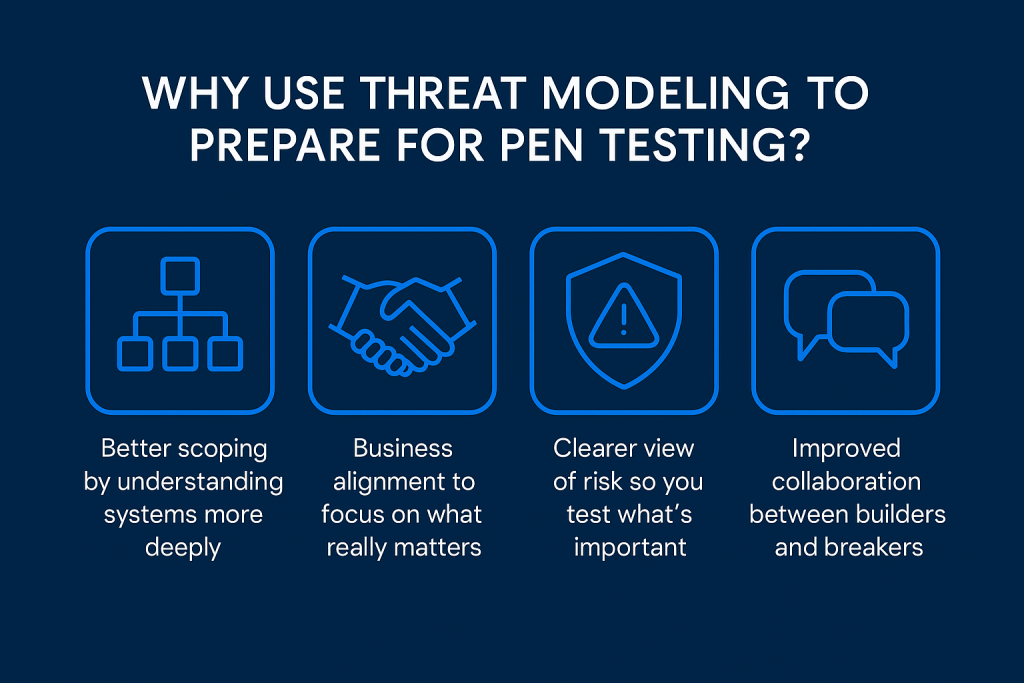In this article, we’ll answer how threat modeling helps with penetration testing scoping (and the intake process related to pen testing).
Threat modeling is a practical, repeatable process that can make many other security activities easier and more effective, including penetration testing.
Threat modeling can help identify what should be included in a penetration test and why. It’s a bit like planning your journey before you hit the road. You’ll get further, faster, and with fewer surprises.
So how exactly does threat modeling help with pen testing scoping, intake, and preparation?
It boils down to: better scoping by improved understanding, better business alignment, clearer view of risk, and improved collaboration.

Improved Scoping Through Technical Understanding
Scoping a penetration test can be hard.
Which parts of the application or system are in scope? What’s most critical to test? Are there third-party APIs, cloud services, or edge cases?
Threat modeling helps answer these questions by giving you (and your penetration testers) a clearer picture of how the system actually works. When teams model out data flows, assets, trust boundaries, and dependencies, they start to see where security weaknesses might be.
Penetration testers can use this to focus on the areas that are most likely to go wrong and skip the parts that don’t matter as much.
In other words: better technical insight equals better testing scope.
Improved Business Understanding
Penetration testing isn’t just about breaking things. It’s about understanding what matters to the business.
What are the crown jewels of the system? What would a real attacker be after? Where is the business value stored or processed?
Threat modeling makes sure this gets included in the conversation. When business stakeholders and technical teams come together to identify threats, everyone gets on the same page about what’s most important to protect.
This helps testers understand not just how to break things, but why it matters if something breaks.
Better Understanding of Risk
Risk is not just about vulnerabilities. It’s about impact.
When you model threats, you don’t just list problems, you also look at likelihood and impact. That means you can prioritize risks better and test the things that matter the most.
Threat modeling helps the team say:
“This area is exposed to the internet, handles sensitive data, and has weak authentication, let’s make sure the pen test covers it thoroughly.”
That’s a huge improvement over ad-hoc testing of what’s available.
Better Communication Between Owning Teams and Testers
Ever had a pen test where the testers were (professionally) guessing what they were supposed to look at?
Threat modeling improves communication between developers, system owners, architects, and penetration testers. By creating a shared model of the system, including threats and assumptions, team members and pentesters know what to expect.
It also reduces misunderstandings and avoids surprises during testing. Everyone can focus on what matters, and nobody’s left wondering what the “real goal” is.
It turns testing from a guessing game into a guided mission.
Try It Yourself
You don’t need to be a security expert to start threat modeling.
Our threat modeling framework is simple, visual, and easy to use. It helps technical and non-technical teams work together to find threats before they turn into real incidents.
And yes, threat modeling also makes your penetration testing program smarter, more focused, and more valuable.
Summary: Why Use Threat Modeling to Prepare for Pen Testing?
- Better scoping by understanding systems more deeply.
- Business alignment to focus on what really matters.
- Clearer view of risk so you test what’s important.
- Improved collaboration between builders and breakers.
- So before you kick off your next penetration test, take a moment to threat model. It might just be the most valuable prep step you take.
Would you like to try a threat modeling session or use a tool that makes this easy? We’ve got one (free, no credit card required) that walks you through it.


